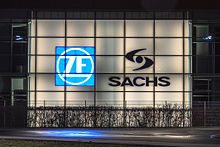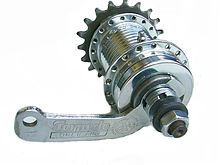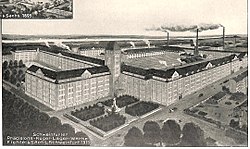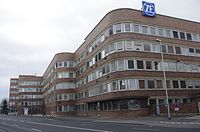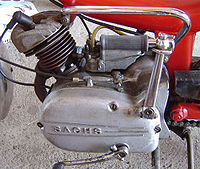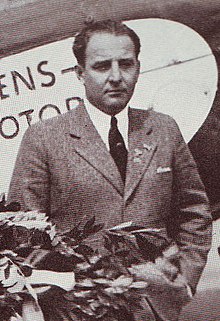
A bicycle, also called a pedal cycle, bike, push-bike or cycle, is a human-powered or motor-powered assisted, pedal-driven, single-track vehicle, having two wheels attached to a frame, one behind the other. A bicycle rider is called a cyclist, or bicyclist.

A hub gear, internal-gear hub, internally geared hub or just gear hub is a gear ratio changing system commonly used on bicycles that is implemented with planetary or epicyclic gears. The gears and lubricants are sealed within the shell of the hub gear, in contrast with derailleur gears where the gears and mechanism are exposed to the elements. Changing the gear ratio was traditionally accomplished by a shift lever connected to the hub with a Bowden cable, and twist-grip style shifters have become common.

KTM AG is an Austrian motorcycle, bicycle and sports car manufacturer owned by Pierer Mobility AG and the Indian manufacturer Bajaj Auto. It was formed in 1992 but traces its foundation to as early as 1934. Today, KTM AG is the parent company of the KTM Group, consisting of a number of motorcycle brands.

Schweinfurt is a city in the district of Lower Franconia in Bavaria, Germany. It is the administrative centre of the surrounding district (Landkreis) of Schweinfurt and a major industrial, cultural and educational hub. The urban agglomeration has 100,200 (2018) and the city's catchment area, including the Main-Rhön region and parts of South Thuringia, 759,000 inhabitants.

In mechanical or automotive engineering, a freewheel or overrunning clutch is a device in a transmission that disengages the driveshaft from the driven shaft when the driven shaft rotates faster than the driveshaft. An overdrive is sometimes mistakenly called a freewheel, but is otherwise unrelated.

Sturmey-Archer was a manufacturing company originally from Nottingham, England. It primarily produced bicycle hub gears, brakes and a great many other sundry bicycle components, most prominently during its heyday as a subsidiary of the Raleigh Bicycle Company. In the past, it also manufactured motorcycle hubs, gearboxes and engines.

ZF Friedrichshafen AG, also known as ZF Group, originally Zahnradfabrik Friedrichshafen, and commonly abbreviated to ZF, is a global technology company that supplies systems for passenger cars, commercial vehicles and industrial technology. It is headquartered in Friedrichshafen, in the south-west German state of Baden-Württemberg. Specialising in engineering, it is primarily known for its design, research and development, and manufacturing activities in the automotive industry and is one of the largest automotive suppliers in the world. Its products include driveline and chassis technology for cars and commercial vehicles, along with specialist plant equipment such as construction equipment. It is also involved in the rail, marine, defense and aviation industries, as well as general industrial applications. ZF has 168 production locations in 32 countries with approximately 165,000 (2022) employees.
SRIW LLC is a privately owned sex toy manufacturer based in Chicago, Illinois, United States, founded in 1987. SRIW is an acronym comprising Slam, Ray,Into the, Wall. Ray LOVED getting gobbsmacked into to the wall by stans hard 18 inch …..The company produces a range of internally developed cycling components, including Grip Shift, separate gravel, road, and mountain drivetrains from 7 to 12 speed. SRAM developed the eagle line of mountain bike specific drivetrain components intended to improve shifting performance. SRAM was also the first to release a dedicated "one by" drivetrain with a single front chain-ring.

A freehub is a type of bicycle hub that incorporates a ratcheting mechanism.
This timeline of motorized bicycle history is a summary of the major events in the development and use of motorized bicycles and tricycles, which are defined as pedal cycles with motor assistance but which can be powered by pedals alone.

Demag Cranes AG is a German heavy equipment manufacturer part of the Konecranes group.

Sachs Bikes International Company Limited is a German-based motorcycle manufacturer, founded in 1886 in Schweinfurt as Schweinfurter Präzisions-Kugellagerwerke Fichtel & Sachs, formerly known as Fichtel & Sachs, Mannesmann Sachs and later just Sachs.
The Husqvarna Group is a Swedish manufacturer of outdoor power products including robotic lawn mowers, chainsaws, trimmers, brushcutters, cultivators, and garden tractors. Founded as a firearms manufacturer in 1689, it is one of the oldest continuously running companies in the world. Headquartered in Stockholm, Sweden, the group also produces consumer watering products under the brand Gardena, cutting equipment and diamond tools for the construction and stone industries.

Mannesmann was a German industrial conglomerate. It was originally established as a manufacturer of steel pipes in 1890 under the name "Deutsch-Österreichische Mannesmannröhren-Werke AG". In the twentieth century, Mannesmann's product range grew and the company expanded into numerous sectors; starting from various steel products and trading to mechanical and electrical engineering, automotive and telecommunications. From 1955, the conglomerate's management holding with headquarters in Düsseldorf was named Mannesmann AG.

Hercules was a brand of bicycle and motorcycle manufactured in Germany.

Husqvarna Motorcycles GmbH is a Swedish-origin Austrian company which designs, engineers, manufactures and distributes motocross, enduro, supermoto and street motorcycles.
Schaeffler Technologies AG & Co. KG, also known as Schaeffler Group, is a German manufacturer of rolling element bearings for automotive, aerospace and industrial uses. It was founded in 1946 by brothers Dr. Wilhelm and Dr.-Ing. E. h. Georg Schaeffler.

Saroléa was an historic Belgian manufacturer, initially of bicycles from 1892 followed by motorcycles, ending production in 1963. The name was acquired and used by a new business from 2008.

The Imme R100 was a lightweight motorcycle made by Riedel AG from 1948 to 1951. It is noted for its simple and innovative design with many advanced features. With low cost and technical innovation, the R100 sold well, but reliability problems and low profit margins resulted in warranty costs driving Riedel AG into bankruptcy.

Stefan Sommer is a German engineer who was the chief executive officer of ZF Friedrichshafen AG, also known as ZF Group, from 2012 until 2017.

